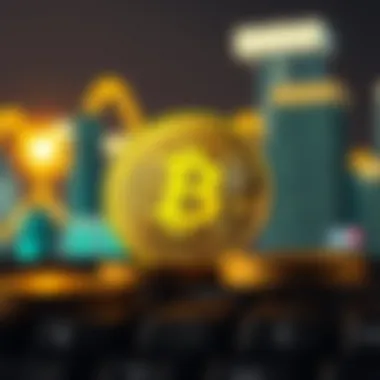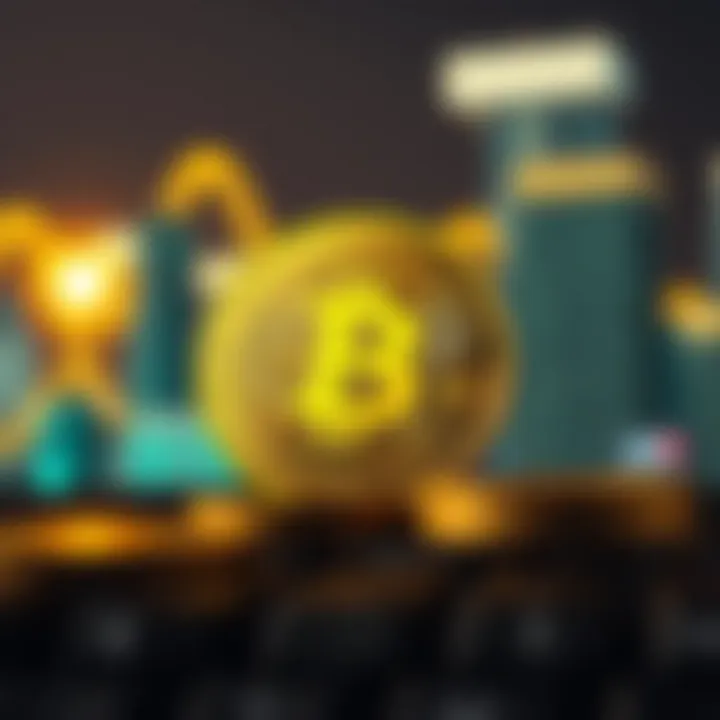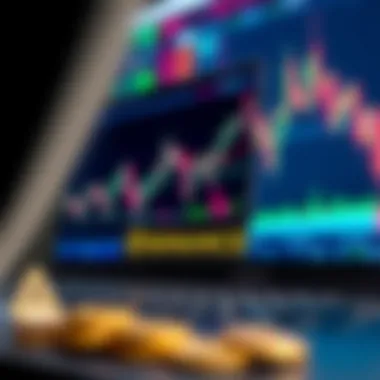Your Comprehensive Guide to Buying Binance Tokens


Intro
In the evolving landscape of digital assets, Binance tokens have emerged as a prominent player. Understanding how to acquire these tokens is essential for those who wish to delve deeper into the world of cryptocurrency. Binance, one of the largest cryptocurrency exchanges globally, offers a range of tokens that cater to various investment strategies. This comprehensive guide provides not only the necessary steps to purchase these tokens but also a deeper understanding of the market dynamics at play.
Investors today face an intricate web of choices. With the rise of various cryptocurrencies and platforms, distinguishing the wheat from the chaff is paramount. Navigating this dynamic space requires a thoughtful approach to account setup, trading pairs, and market trends. It's not just about buying tokens; it's about enhancing your investment portfolio intelligently.
In this article, we will explore:
- The latest trends in cryptocurrency and how they impact token acquisition.
- Diverse investment strategies to consider when engaging with Binance tokens.
- Practical advice on account setup and understanding trading pairs.
- Evaluating market conditions to inform your purchase strategies.
Ultimately, the objective is to equip you with the knowledge needed to make well-informed decisions, promoting a safe and confident trading experience.
Trends in Cryptocurrency
The cryptocurrency market is vibrant and ever-changing. Recognizing current trends can significantly influence investment success.
Current Market Trends
Over the past year, market volatility has become the watchword for traders and analysts. Notably, the continuous rise of decentralized finance (DeFi) projects has shifted focus from traditional trading to innovative financial applications. Established cryptocurrencies like Bitcoin and Ethereum remain popular, yet newer tokens are entering the fray with increasingly sophisticated use cases.
Also, there’s been an observable uptick in the integration of non-fungible tokens (NFTs) into various sectors. Collectors and investors alike are eager to understand how these unique assets function, making them a hot topic of discussion.
"Being aware of trends is like having a crystal ball; it doesn’t predict the future, but it gives you insight into the right direction."
Emerging Technologies in Blockchain
As investors seek to maximize their returns, new technologies within the blockchain space are also sprouting up. For instance, the advent of layer-two scaling solutions aims to increase transaction throughput, significantly lowering fees and enhancing efficiency. As projects adopt these technologies, it’s vital for potential investors to know which tokens may benefit.
Not all innovations will bear fruit, yet the ones that do can substantially increase the demand for certain Binance tokens. Keeping an ear to the ground on technologic advancements can serve you well in evaluating your options.
Investment Strategies
Investing wisely is the cornerstone of success in the cryptocurrency realm. A clear strategy defining your goals can help you navigate the tumultuous waters of crypto exchanging.
Long-term vs. Short-term Investing
When thinking about investment, you need first to consider your horizon. Long-term investing in Binance tokens often means you believe in the future potential of these assets. In contrast, short-term investing is often speculative in nature, capitalizing on fluctuations for quick profits.
Before making any purchase, weigh the following:
- Your Risk Appetite: Can you afford to wait or do you need immediate returns?
- Market Volatility: Are you comfortable with the highs and lows?
- Token Fundamentals: Does the token have a solid use case?
Risk Management Techniques
As with any investment, risk management is essential. Setting stop-losses can prevent significant losses and help manage emotions during market fluctuations. Diversifying your portfolio by not putting all your eggs in one basket can also safeguard against unforeseen drops in value.
Tools like Binance's referral program and staking options can further enhance your investment strategies by maximizing your earnings.
By understanding both market trends and investment strategies, investors can proceed with confidence, equipped with the insights needed to navigate the Binance ecosystem.
Understanding Binance Tokens
Understanding the dynamic world of Binance tokens is crucial for anyone stepping into the realm of cryptocurrency. These tokens not only serve as digital assets but also embody various forms of participation in the rapidly evolving financial landscape. Navigating through Binance tokens means not only engaging with a specific platform but also understanding the broader implications of blockchain technology. So, what’s the big deal with Binance tokens? They enable investors and traders to access a wide range of functionalities, leverage trading opportunities, and effectively manage their crypto portfolios, making them a fundamental part of the Binance ecosystem.
What Are Binance Tokens?
At their core, Binance tokens are cryptographic tokens that operate on the Binance platform, which is one of the largest cryptocurrency exchanges globally. These tokens can be viewed as a ticket that grants access to various services within the Binance ecosystem, such as trading discounts, staking rewards, and participation in token sales. One of the distinguishing marks of Binance tokens is their underlying technology, the Binance Smart Chain, which allows for faster and more cost-effective transactions compared to other networks. In simple terms, Binance tokens empower users, giving them various ways to optimize their trading and investing endeavors.
Types of Binance Tokens
When we think about Binance tokens, it’s essential to categorize them into specific types that serve different functions within the ecosystem. Here are notable classes:
Binance Coin (BNB)
Binance Coin, commonly abbreviated as BNB, is the flagship token of the Binance ecosystem. Initially created as a utility token for trading fee discounts, it has evolved significantly since its launch. One major aspect of BNB is its utility beyond mere trading discounts; holders can use BNB for various functions, including payment of transaction fees on the Binance Smart Chain and participating in token launches on Binance Launchpad.
A standout characteristic of BNB is its deflationary model, wherein Binance regularly buys back and burns a portion of BNB tokens, thus reducing supply over time. This unique feature fosters scarcity, making it a potentially lucrative asset for investors. However, it’s important to keep in mind that investment in BNB, like any other asset, comes with risks related to market fluctuations and the overall performance of the exchange.
Tokenized Assets
Tokenized assets represent another significant type of Binance tokens. These are digital representations of real-world assets, utilizing blockchain technology to offer increased accessibility and liquidity. This category includes everything from real estate to stocks, and even precious metals, allowing traditional investors to tap into the crypto market easily.
The key attraction of tokenized assets is their ability to fractionalize large investments, enabling even small-scale investors to diversify their portfolios without the hefty price tags often associated with traditional assets. Additionally, transparency through smart contracts ensures trust in these transactions. On the flip side, potential regulatory issues and market adoption still pose challenges for widespread acceptance.
Importance of Binance Tokens in Crypto


Binance tokens play a pivotal role in advancing the cryptocurrency space. They provide unique opportunities for users to interact with blockchain-based systems, enhancing the trading experience and offering various financial products previously unavailable to retail investors. Furthermore, tokens like BNB and tokenized assets bridge the gap between traditional finance and the burgeoning crypto market. Investors not familiar with cryptocurrency find a soft landing into the digital space through tokenized assets, fostering an environment where innovation can flourish.
In summary, understanding Binance tokens is more than a matter of knowing the tokens themselves; it’s about recognizing their critical function and potential in reshaping the financial landscape. With their diverse applications and benefits, they contribute significantly to the evolution of how we perceive and manage value in the digital age.
Setting Up a Binance Account
Setting up a Binance account is the first crucial step towards engaging in the world of cryptocurrency trading. The importance of this process cannot be overstated, as it serves as the foundation for all transactions and activities within the Binance platform. A well-executed setup ensures that users can navigate the site efficiently, access a variety of trading pairs, and ultimately manage their portfolios with greater ease and security.
Several considerations come into play when establishing an account with Binance. The platform is known for its vast array of features and user-friendly interface, but only if one knows how to utilize them effectively. In this section, we will delve into the steps required to create an account, verify it, and secure it to maximize your trading potential.
Creating Your Account
Establishing an account on Binance is relatively straightforward. Users must visit the official Binance website and locate the "Register" button at the top right corner of the page. Here’s a guide to walk you through the process:
- Registration Details: Enter your email address and choose a strong password. It is wise to employ a mix of letters, numbers, and special characters to make your password more secure.
- Terms and Conditions: Agree to the terms and conditions provided by Binance. Take a moment to read them to understand your responsibilities and rights as a user.
- Confirmation: After submitting your registration info, Binance will send a confirmation email. Check your inbox and click the link to verify your email.
Completing these steps creates your Binance account, but that's just the beginning. Remember, a secure foundation leads to successful trading endeavors.
Account Verification Process
Verification on Binance is essential for various reasons, primarily revolving around security and compliance with regulatory standards. This step is often referred to as KYC, or Know Your Customer, and it aims to prevent fraudulent activity within the platform. Here’s what you need to do:
- Documents Needed: Prepare to upload documents proving your identity. Generally paired with a government-issued ID, proof of residence is also required. These documents help in confirming your identity and address, ensuring safety for all users.
- Submission: Once you have the documents, navigate to the verification section on your account dashboard and upload the necessary files. Binance will review these documents, a process that usually takes a few minutes to a couple of days.
- Status Check: After submission, keep an eye on your email for updates on your verification status. Once approved, you can access more advanced features of the platform and participate in trades that may have been restricted otherwise.
It’s crucial to remember that the more thorough your verification, the higher your transaction limits will be.
Setting Up Two-Factor Authentication
Two-Factor Authentication (2FA) is often the unsung hero of online security, and Binance advocates for its use to bolster account protection. Here’s how to get started with setting up 2FA:
- Choosing an App: There are various options available, such as Google Authenticator or Authy. Select the one that aligns with your preferences and download it.
- Link Your Account: Follow the instructions in your Binance account settings to link your chosen authentication app. This process usually involves scanning a QR code or entering a secret key.
- Verification Code: Once linked, the 2FA app will generate a time-sensitive code to access your account. Input this code when prompted during your login process.
Implementing this extra layer of security not only protects your account but also gives you peace of mind, allowing you to focus more on trading rather than worrying about potential breaches.
By carefully setting up your Binance account, completing verification, and enabling two-factor authentication, you establish a secure trading environment. Each step builds upon the last, forming a robust foundation that will serve you well as you dive deeper into the complexities of cryptocurrency trading.
Funding Your Binance Account
Funding your Binance account is a crucial step in the journey of acquiring Binance tokens. Without the right funding method in place, trading and purchasing cryptocurrency can become a cumbersome process or even impossible. Think of your funding as the fuel that powers the entire trading engine. By understanding the various funding methods and their implications, you can choose the one that aligns best with your trading strategy and personal preferences.
Choosing a Funding Method
Selecting a funding method is a pivotal decision for anyone looking to get involved in trading or investing. Several options exist, each with its own pros and cons. Whether you prefer the convenience of a credit card or the reliability of a bank transfer, knowing your options can make all the difference.
Bank Transfer
Bank transfers are one of the most traditional and widely used methods to fund a Binance account. They generally involve moving money directly from your bank account to your Binance account. The key characteristic of this method is its reliability and security. Often considered beneficial for larger transactions, bank transfers tend to attract minimal fees compared to other payment methods.
A unique feature is the verification process that comes with it, ensuring that the transaction is securely executed. However, the downside can be the slower processing times, which means if you're looking to capitalize on a market opportunity quickly, you may find yourself waiting. In summary, bank transfers are a stable choice when ease of mind and security are priorities.
Credit/Debit Card
Using a credit or debit card is another popular option for funding your Binance account. It's all about instant gratification here; your funds can be available almost immediately. The seamless nature of card payments is one of its biggest draws, especially for new users who might be wary of the complexities of cryptocurrency transactions.
However, this method often comes with higher fees compared to bank transfers. Additionally, there's a limit on how much you can deposit, depending on your card issuer. So, while instant funding is indeed appealing, one should always be mindful of the transaction costs involved.
Cryptocurrency Deposit
Funding your account through cryptocurrency deposits might seem a bit paradoxical, but it's a viable option for those who are already into the crypto world. If you own other cryptocurrencies like Bitcoin or Ethereum, you can transfer them directly to your Binance account. This method is fast and straightforward, eliminating the need for fiat currency.
The key characteristic here is the ability to dive into trading without liquidating your assets first. That said, you need to sweat the details; there may be withdrawal fees imposed by the previous exchange, and not all cryptocurrencies are accepted on Binance. This approach is best suited for those who are comfortable navigating within the crypto ecosystem.
Understanding Deposit Fees
Before committing to any funding method, it’s essential to have a grip on the deposit fees involved. Each funding method has its own fee structure that can eat away at your profits if not considered beforehand. Bank transfers may come with low or zero fees, while credit card transactions generally carry higher rates. Being aware of these costs upfront will enable traders to budget effectively and avoid unpleasant surprises when they go to trade.
Managing Currency Conversion
Whenever you’re dealing with cryptocurrencies, managing currency conversion can become a headache. Binance supports various fiat currencies, and knowing how to convert your local currency into a suitable one for trading can save you time and money. The platform offers tools to help you navigate this aspect, but always keep an eye on the conversion rates. Making timely conversions can lead to significant cost savings and more successful trades.
Navigating the Binance Interface
Understanding the Binance interface is essential for anyone looking to make purchases and trade efficiently on this popular exchange. The way it’s set up can seem overwhelming at first. However, once you get through the initial learning curve, you’ll find that it’s designed to facilitate your trading experience. By knowing where to look and what to pay attention to, you can unlock the full potential of your Binance account.
Overview of the Trading Dashboard


The trading dashboard serves as the focal point for all your activities on Binance. It's here that you can interact with live market data and manage your orders. When you first log in, you'll encounter various components such as charts, price tickers, and your current holdings.
- Charts: These display real-time data, allowing you to analyze trends. Understanding how to read these will give you insights into price movements.
- Order Book: This is vital for seeing live buy and sell orders. Familiarize yourself with it to gauge market depth.
- User Portfolio: Your holdings will appear here, showing not just totals but also performance over time.
Navigating this dashboard efficiently aids in making quick trades and informed decisions, which is crucial in the fast-paced world of cryptocurrency trading.
Understanding Trading Pairs
In the Binance ecosystem, trading doesn’t just happen with one currency. Instead, you’ll encounter trading pairs, which show how much of one currency can be bought with another. For example, if you see BTC/USDT, it indicates the exchange rate between Bitcoin and Tether, a stablecoin.
Knowing how to interpret these pairs can lead to better trading decisions:
- Base Currency: This is the first currency in the pair, typically determining how trade pricing will work. In the BTC/USDT pair, Bitcoin is the base.
- Quote Currency: This is the second one, which indicates how much of the base currency you can buy or sell. For example, if BTC is at 50,000 USDT, then you will need 50,000 Tether to buy 1 Bitcoin.
By understanding this, you can make comparisons and look for favorable trading opportunities.
Using Limit and Market Orders
When it comes to placing trades on Binance, knowing the difference between limit and market orders is a game changer. Each order type serves a different purpose that can significantly affect your trading outcomes.
- Market Orders: This is the simplest type; you buy or sell immediately at the current market price. If speed is of the essence, this is your go-to option. However, be mindful that the price may change quickly, and there’s no guarantee you’ll get the price you initially saw.
- Limit Orders: This is more strategic. Here, you specify the exact price at which you want to buy or sell. The order only executes if the market reaches that price. This is where patience is needed; it may take more time, but it’s beneficial for securing trades at desirable rates.
By mastering these two types of orders and understanding when to deploy either option, your trading efficacy can improve significantly.
"Understanding the interface coupled with sound trading strategies will aid in navigating the complexities of the cryptocurrency market."
Executing Your Purchase
Executing a purchase on Binance is not just a mere transaction; it’s the gateway to navigating the vast sea of cryptocurrency opportunities. Getting this right can mean the difference between a successful investment and a missed opportunity. Understanding how to effectively place orders, track their progress, and know how to handle any hiccups along the way is crucial for both novice and seasoned traders alike. In this segment, we will dissect the process into manageable parts, ensuring you’re well-equipped to make confident buying decisions.
Placing an Order
When it comes to placing an order on Binance, the first step is understanding the different types of orders available. Binance offers a few key order types:
- Market Orders: This is the simplest method. You buy or sell at the best available price. If you’re eager to get your hands on some tokens quickly and don’t mind slightly fluctuating prices, a market order is your go-to.
- Limit Orders: Unlike market orders, with limit orders, you set the price at which you’re willing to buy or sell. This might take longer as your order will only execute when the market hits your specified price. It’s a great strategy for those who are price-sensitive.
- Stop-Limit Orders: These orders become active once a designated stop price is reached. They’re useful for protecting your investments or ensuring you get in at the right moment.
Before clicking that purchase button, consider adding a small note or reminder about why you're buying a certain token. A little perspective goes a long way when the market gets a little bumpy.
Tracking Your Order Status
Once your order’s placed, it’s time to keep an eye on it. On Binance, tracking your order is straightforward. You can navigate to the ‘Orders’ tab on your dashboard to view their current status. Here, you can see:
- Open Orders: These are your current active orders waiting to be filled.
- Order History: This section provides insights into past transactions, helping maintain a clear overview of your purchasing habits.
Understanding how to track your orders allows you to gauge the market and make strategic decisions. If prices start shifting, you might want to adjust your strategies accordingly.
Handling Order Failures
Not every purchase goes as planned. Sometimes, orders may fail due to insufficient funds, market volatility, or even server issues on Binance’s side. Here’s how to tackle those bumps in the road:
- Check Your Balance: Always ensure you have enough funds available in your account to cover the purchase and any potential fees.
- Review Market Conditions: Ensure that market conditions align with your order. If the token price is fluctuating wildly, it may affect order fulfillment.
- Be Patient: The crypto market doesn't always move at breakneck speed. If an order fails, give it a moment before trying again.
- Contact Support if Needed: If you encounter repeat issues, reaching out to Binance support can provide clarity.
While failing an order can be frustrating, understanding the reasons behind it is a key part of becoming a savvy trader.
In summary, executing your purchase on Binance requires careful consideration of the order types, tracking their status diligently, and knowing how to manage failures. The process is integral not only to acquiring Binance tokens but also to developing your overall trading acumen.
Post-Purchase Considerations
Once the excitement of acquiring Binance tokens settles in, it’s easy to overlook what comes next. However, taking time to consider how to manage and protect your investment post-purchase is crucial. The crypto market is notoriously volatile, so keeping a keen eye on your assets can make a world of difference in preserving value and ensuring that your investment journey remains on solid ground.
Storing Your Tokens Securely
Wallet Options
When it comes to storing your tokens, the choice of wallet can greatly influence their safekeeping. There are a few popular options out there that cater to various needs.
- Hardware Wallets: Physical devices that store your tokens offline, offering a high level of security. A key characteristic here is that they are less prone to online attacks. Companies like Ledger and Trezor are well-known for producing such hardware wallets. They protect your private keys from being exposed to the internet.
- Software Wallets: These are applications that can be downloaded on your computer or smartphone. They provide easier access to your tokens but come with varying levels of security. Mobile wallets like Trust Wallet or software wallets such as Exodus are common choices. Their advantage lies in convenience, yet a downside is that they can be more susceptible to hacking.
In essence, each wallet option has its pros and cons. Hardware wallets offer the peace of mind that comes with offline storage, while software wallets are about accessibility—a balance worth considering based on your needs.
Best Practices for Security
Taking ownership of your digital assets means prioritizing security. Implementing best practices can go a long way in protecting your hard-earned tokens. First off, using robust passwords that combine letters, numbers, and special characters is a must. Moreover, avoiding easily guessed phrases enhances your defenses.
Additionally, enabling two-factor authentication (2FA) adds an extra layer of security. It can be a hassle, but the benefits of preventing unauthorized access far outweigh any inconvenience.


Furthermore, keeping your software updated—be it your wallet or your device—ensures you have the latest security patches. It’s akin to locking your doors at night; you may not think it’s necessary, but it’s wise and can prevent unwanted surprises.
- Unique Features to Consider: Regularly backing up your wallet and securely storing recovery phrases can save you in case of loss or theft. Use dedicated apps for secure storage of this sensitive info.
By employing strict security measures, you’ll not only safeguard your tokens but also gain peace of mind moving forward.
Tracking Market Changes
Monitoring market conditions is vital after your purchase. The crypto landscape shifts rapidly—news, market trends, and economic indicators can send prices soaring or plummeting. Utilize price tracking apps or platforms like CoinMarketCap to stay abreast of the changes. Setting alerts for significant fluctuations can help you make timely decisions about your investment portfolio. Additionally, following crypto news websites and engaging in forums like Reddit can provide insights into potential market movements, helping you react swiftly when necessary.
When to Consider Selling
At some point, the question arises: when is it the right time to sell? Recognizing optimal selling opportunities can distinguish a savvy investor from a rookie. Monitor market sentiment and specific triggers like reaching a goal price, or shifts in technology related to the tokens you hold. Setting clear goals before investing is also important; whether it’s a long-term hold or a short-term flip, clarity can guide your selling decisions. And always reflect on the proverbial saying, "sell high, buy low"—a mantra worth sticking to when strategizing your next move.
Advanced Trading Strategies
In the realm of cryptocurrency, understanding advanced trading strategies can be the difference between realizing profits and watching your investment dwindle. Engaging in these strategies helps traders, investors, and analysts navigate the often turbulent waters of the market with greater confidence and precision. Instead of simply buying and holding, advanced strategies allow you to have a more active role in managing your crypto portfolio. This means adapting to changing market conditions, properly timing trades, and leveraging market sentiment to maximize returns.
Understanding Technical Analysis
Technical analysis serves as the backbone for many trading strategies. It involves analyzing price movements and trading volumes to forecast future movements. Traders applying this method often make use of charts, patterns, and indicators to make informed decisions. For instance, moving averages and candlestick patterns are commonly used to identify trends and potential reversal points.
Here's a simple breakdown of core concepts:
- Price Charts: Understanding candlestick patterns provides insights into market sentiment – rising prices may indicate bullish sentiment, while falling prices can suggest bearish trends.
- Support and Resistance Levels: Recognizing these levels is crucial for setting entry and exit points. Support is a price level where an asset tends to stop falling, while resistance is where it usually stops rising.
- Indicators: Add-ons like the Relative Strength Index (RSI) help determine if a market is overbought or oversold, guiding your decisions on whether to buy or sell.
By mastering technical analysis, traders position themselves to respond effectively to market fluctuations, potentially yielding greater profits.
Market Trends and Indicators
Market trends define the direction of prices, and identifying them early can enhance a trader's ability to profit. Trends can be upward, downward, or sideways, and understanding which one you’re dealing with is key.
Indicators can assist in determining these trends. For example:
- Moving Averages: Daily or weekly moving averages smooth out price action, helping traders spot the direction of the trend. A cross of shorter moving averages above longer ones often signals a bullish trend.
- Volume Indicators: Increased trading volume can validate a trend. If prices rise with increasing volume, it often indicates a strong trend; conversely, rising prices with thin volume suggest weakness.
Being alert to these trends and indicators enhances the decision-making process, allowing you to not just react but strategically plan your next moves.
Risk Management Techniques
Risk management is one of the foremost considerations in trading. Strategies to protect your capital can prevent significant losses and help maintain longevity in the market. Here are some effective techniques:
- Position Sizing: Calculate the amount of capital to risk on each trade. A commonly suggested guideline is to risk no more than 1-2% of your total capital on a single trade.
- Stop-Loss Orders: Placing stop-loss orders can limit potential losses by automatically closing a position at a predefined price point. This is essential for minimizing risk and protecting profits.
- Diversification: Avoid putting all your eggs in one basket. Spreading investments across different assets can reduce overall risk, as not all assets will perform poorly at the same time.
Effective risk management is a strategy that often separates successful traders from those who struggle.
Resources for Continued Learning
In the ever-evolving world of cryptocurrency, the phrase "knowledge is power" couldn't ring truer. Equipping yourself with the right resources allows you to stay ahead in a field characterized by fast-paced changes. Continuous learning is essential, not just for understanding the nuances of Binance tokens, but for navigating the broader landscape of digital assets.
Online Courses and Tutorials
Online courses offer structured learning and are particularly beneficial for those who prefer a guided approach. Several platforms provide in-depth training specifically focused on Binance and cryptocurrency trading. Options like Coursera, Udemy, and LinkedIn Learning feature courses ranging from beginner to advanced levels.
- Benefits of Online Courses:
- Structured curriculum that ensures all topics are covered.
- Quizzes and interactive sessions that reinforce learning.
- Availability of expert instructors for insights and answering queries.
One example is the course "Cryptocurrency Trading: Technical Analysis Masterclass," which covers various strategies for trading on platforms like Binance. As you delve deeper, these lessons can boost your confidence.
Recommended Reading
Books and articles written by seasoned professionals in the crypto space can offer invaluable perspectives. Texts such as "Mastering Bitcoin" by Andreas Antonopoulos dive into the technology behind cryptocurrencies, while others like "The Basics of Bitcoins and Blockchains" provide comprehensive insights into trading and investing.
- Notable Titles:
- The Bitcoin Standard by Saifedean Ammous
- Cryptocurrency: How Bitcoin and Digital Money Are Challenging the Global Economic Order by Paul Vigna and Michael J. Casey
In addition, following financial news from reputable sources such as Bloomberg or Coindesk helps you stay updated on market trends and regulations that may affect Binance transactions.
Community and Support Forums
Community engagement can prove to be a lifeline. Forums like Reddit and various cryptocurrency Discord channels are treasure troves of information. Interacting with other users allows you to share experiences, seek advice, and learn best practices.
- Key Platforms:
- Reddit offers a plethora of discussions and resources.
- The Binance Support Forum is a place to ask questions and get support directly related to the platform.
“Joining a community can be your safety net in the roller-coaster ride of cryptocurrency investing.”
Engaging in these platforms will provide you not only technical insights but also emotional support during market fluctuations, making your experience in the crypto world all the more enriching.
By incorporating these resources into your learning regimen, you'll not only enhance your knowledge but also empower your investment strategies in cryptocurrency.







